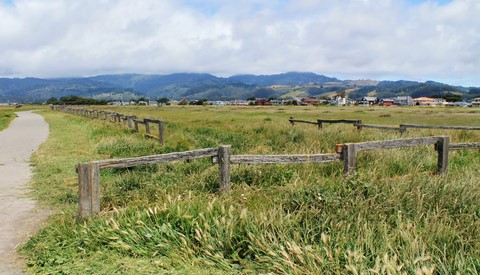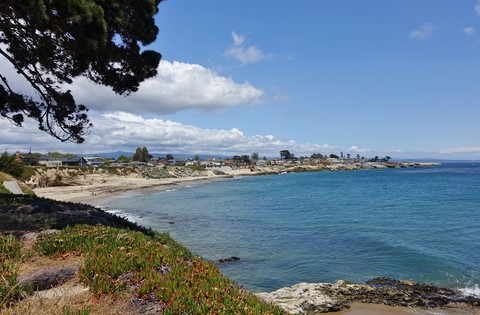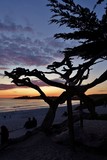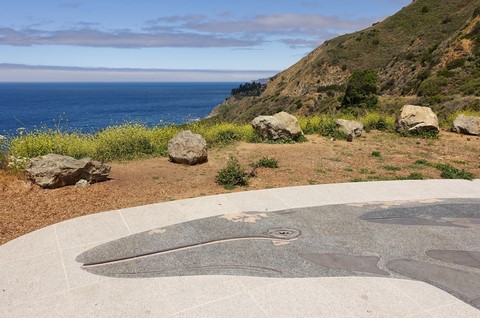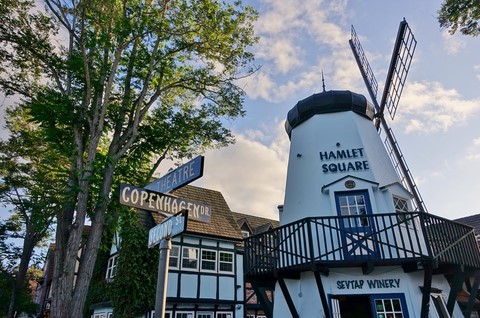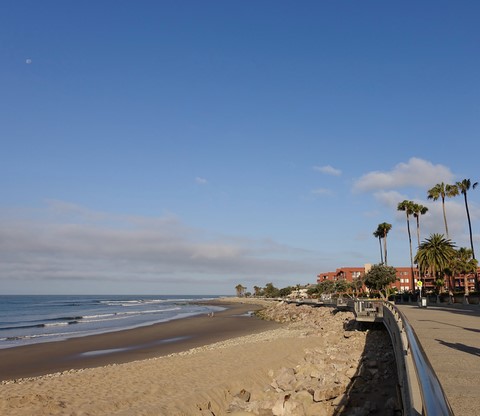California - Central Coast
You can click on pictures to enlarge them
Half Moon Bay
South of San Francisco, we took the famous Route 1. It runs along the amazing Californian coast with its jagged cliffs that undergo the merciless assaults of the Pacific Ocean in a breathtaking spectacle. Naturally winding because it follows the shape of the coast, it makes every driver slow down, thus enjoying that unforgettable panorama.
We made a first stop at Half Moon Bay, which owes its name to its wide crescent-shaped yellow sand beach. Varied vegetation covers cliffs with colors. Wild and solitary, it is especially known by surfing lovers for its world-famous spot Mavericks and its huge and dangerous waves that only the most experienced and the most adventurous come to brave.
Santa Cruz
Santa Cruz is also closely linked to surfing. And for good reason: that small coastal town is precisely where it has been imported all the way from Hawaii. Besides, the Santa Cruz Surfing Museum traces the history of that sport which has spread all around the world since then. Moreover, the first wet suits have been conceived there. The honor and the credit go to the O’Neill brand, which bears the name of its founder, a local.
Beaches are both beautiful and tortured. Low steep cliffs covered in places by colored flowers often undergo the fierceness of the wind and the waves from the ocean.
The town itself displays some nice Victorian houses in the same style as the ones in San Francisco. However, its lovely very varied wooden houses are well and truly the ones that give it that so particular character. The hippy culture can really be found there, and you will meet any kind of eccentric – but always nice – people.
Santa Cruz is lively during weekends and school breaks, with obviously a peak attendance in July and August. But if you visit it outside of those periods, you will find it tinged with a very captivating nostalgia. Its success fell into disuse decades ago, and it looks like a ghost town sometimes. Its railway is abandoned and trains do not run any longer there. Its long wharf is hundred-year old, just like its boardwalk. The old fairground amusements remain, notably its old wooden roller coasters, but they have been eroded little by little by the merciless effects of the sea breeze. A strange but very pleasant atmosphere hangs over the beach and the boardwalk. Then, we can get caught up in time travel and be charmed: Santa Cruz, as well as its inhabitants, has a little something unconventional and old-fashioned, which makes it likeable. It seems to be out of time and out of the world, which makes it unique.
Monterey Peninsula
Monterey is a coastal town which is well known for its Monterey Bay Aquarium, and above all for its famous jazz festival. The other attractions are Cannery Row, the district of former canneries depicted by John Steinbeck in his novel that bears the same name, Fisherman’s Wharf where are many shops and restaurants, and its numerous bars that offer live music. Old fishing port, it is the shadow of its former self because of an obvious tourist overstatement. You will not linger there and you will prefer visiting the rest of the peninsula, a true miracle of nature.
Pacific Grove is in the extension of Monterey. It is a charming small residential town reserved for a rich population. Point Piños Lighthouse is an old lighthouse from the mid 19th century. It fits perfectly into the beautiful bay scenery. It is no longer in operation but you can visit its ground floor.
Pebble Beach (photo) is the starting-point of the extraordinary coastal road 17-Mile Drive. Admittedly, there is a more than $10 fee, but we did not regret it for the succession of spectacular views that met our eyes was breathtaking. The cypress forest and beaches are perfectly preserved. The waves from the Pacific Ocean break on the white sand and on the rocks, some of which are raised towards the sky. The greenery of very nice world-famous golf courses is nestled into the landscape. It is hard not to succumb to wonder, which leads us to make many stops. The one in Lone Cypress is obviously a must-see: as the name suggests, a lonely cypress tortured by successive winds proudly stands up on a rocky promontory in tormented water. It is one of the idealized images of the Californian coast.
Carmel-by-the-sea
The 17-Mile Drive ends at the entrance of that enchanting coastal town with beautiful white sand beaches. Lovely houses filled with charm stand in the middle of cypress and eucalyptus. The sense of harmony and perfection is so extreme that signaling, illuminated signs and advertising posters are prohibited.
It owes its name to the San Carlos Borromeo del Rio Carmelo Mission, which is a Carmelite mission founded in the late 18th century. It is remarkably preserved, and its superb rose garden embalms the place with a heady perfume.
Carmel has been attracting since the early 20th century many artists seeking peace and isolation. Therefore, it has always kept an artistic tradition, witness the numerous art galleries and the various festivals. Given that the town is not that big, do not hesitate to get lost in its streets, some of which hide unsuspected treasures, like superb gardens or inner courtyards.
Big Sur
Almost free from all traces of civilization, it is one of the wildest and the most preserved places on the Californian coast. There, nature is straight and raw; a nature as splendid as tortured, where impressive sheer cliffs proudly stand up in front of the merciless assaults of the Pacific Ocean, which waves come and break on their rocks in a virtually constant foam and mist explosion. Covered with flora and greenery, their ocher color offers a striking contrast with the blue color of the ocean. The novelist Henry Miller retired there for long years, seeking for solitude and questioning. Besides, a library is dedicated to him: the Henry Miller Memorial Library, which is in a wooden chalet, in the purest Big Sur spirit.
The effect of vastness is broken in places by the sudden appearance of small heavenly coves after one of the countless bends of Route 1. Driving there is a real delight. We are caught in a childish impatience thinking of the next spectacle view that will meet our eyes. On the other hand, we feel like enjoying the moment for the landscape is so varied that every mile is new discovery. We marvel at crossing the Bixby Creek Bridge, which spans the canyon that bears the same name. Real architectural feat, it is one of the most photographed bridges in the country.
You can discover the Andrew Molera State Park riding a horse, always closer to nature. Julia Pfeiffer Burns State Park offers many hiking trails in idyllic settings. One of them crosses a redwoods forest, which are among the biggest trees in the world. Still, one of the spots that appealed to us the most was McWay Fall, waterfall on a heavenly beach in the heart of a steep-sided cove stunningly beautiful. Pfeiffer Beach is an extraordinary beach but rather difficult to access. We might as well say that it has to be earned. It is very appreciated by the most experienced surfers, since conditions are difficult because of strong currents. Photographers like to go there at sunset, when sunbeams cross the narrow opening of the impressive arch that rises in the water. That moment is always magical. However, the most surprising is its superb purple sand, phenomenon caused by the presence of manganese. Finally, Big Sur has a lighthouse erected in the late 19th century: Point Sur Lighthouse.
Solvang
It is one of the most unusual places on the coast: a Danish village founded in the early 20th century by Danish of pure descent! Except the luminosity and the mildness of the Central Coast, we could believe with a hint of imagination that we are in Denmark. Half-timbered houses - some of them with red bricks - with thatched roofs or slate roofs are numerous. Colors are varied, and wrought iron signs are charming. On Atterdag Square, an old wind turbine proudly rises and gives the place some additional character. Some windmills complete the picture. Some restaurants and shops offer Danish specialties. The Hans Christian Andersen Museum is dedicated to traditional tales for children. And if all that is not enough to give you the feeling of having set foot in Northern Europe, come to Danish Day in September. You will marvel in front of typical folk performances, especially dancing.
Solvang is located in the Santa Barbara Wine Country, the other wine region in California. The very hilly landscape is covered with very nice vineyards. They were filled with splendid warm and blazing colors under the late afternoon sun as we were crossing it… and on the other side of the road was still that beautiful Pacific Coast, which had not been out of your sight all day, for it filled us so with wonder. It is one more reason why driving along that famous Route 1 is a real enchantment!
Ventura
We made a night stop in that small town after that day marked by the long crossing of a succession of breathtaking landscapes. We just regretted that an unexpected event on the road delayed us for a long time, preventing us from visiting beautiful Santa Barbara, and its mission known for being one of the nicest in California. Maybe during our next trip there…
Ventura is a small seaside resort, unpretentious and lowly prized by tourists, which has necessarily its advantages. Its nice city center is very pleasant. So are its sea front and its pier. You can visit the Mission San Buenaventura, founded in the late 18th century. However, only a little part of it remains, well restored by the way. Indeed, it was badly damaged over time because of a fire and many earthquakes.
The Albinger Archeological Museum will teach you a lot about the numerous archaeological discoveries in the surroundings. Some of them date from about 3500 years and therefore allow us to know more about primitive people in California.
Finally, Ventura is one of the starting-points to Cannel Islands National Park, an archipelago of five islands that enjoy very rich fauna and flora.
Published on October, 28th 2017



